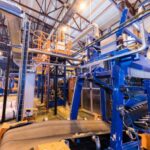Introduction: Why Bulk Drug Parks Matter for India’s Pharma Future
India is one of the world’s largest pharmaceutical producers, but it has long relied on imports of bulk drugs, Active Pharmaceutical Ingredients (APIs), and Key Starting Materials (KSMs). To reduce this dependency and strengthen domestic manufacturing, the Promotion of Bulk Drug Parks scheme was launched by the Government of India in 2020.
This scheme supports the development of state-of-the-art bulk drug parks with common infrastructure facilities, ensuring cost efficiency, environmental compliance, and improved competitiveness of Indian pharma manufacturing.
For pharmaceutical companies, investors, and state-level industry stakeholders, understanding the bulk drug parks guidelines, DPR requirements, grant-in-aid provisions, and incentives is critical. At the same time, navigating these complex processes often requires expert consultancy to unlock the maximum subsidy and scheme benefits.
Understanding the Promotion of Bulk Drug Parks Scheme
The Promotion of Bulk Drug Parks scheme was designed to provide financial support and infrastructure to reduce India’s reliance on imports of APIs and intermediates.
- Total financial outlay: ₹3,000 crore
- Number of parks supported: 3 bulk drug parks
- Grant-in-aid limit: up to ₹1,000 crore per park
- Funding pattern: 70% of the project cost (90% for North-Eastern and hilly states) for common infrastructure facilities
The scheme focuses on setting up large-scale, well-planned parks where pharmaceutical units can share resources, optimize costs, and achieve economies of scale.
Key Features of Bulk Drug Parks
The bulk drug parks guidelines outline the structure and requirements for setting up these industrial hubs. Some major highlights include:
- Land Requirement: Minimum 1,000 acres (700 acres for North-Eastern and hilly states).
- Common Infrastructure Facilities (CIF): Central effluent treatment plants (CETPs), solvent recovery systems, warehouses, testing laboratories, logistics, safety centers, and more.
- Environmental Compliance: Support for waste management, zero liquid discharge (ZLD) systems, and advanced safety mechanisms.
- Centre of Excellence: Facilities for R&D, industry-academia linkages, and IP management services.
These provisions not only encourage domestic production but also give global investors confidence in India’s pharma ecosystem.
Bulk Drug Park DPR: The Backbone of Project Approval
One of the most important components of the scheme is the bulk drug park DPR (Detailed Project Report).
The DPR is not just a technical document — it is the foundation of the proposal. It includes:
- Feasibility studies and risk assessments
- Detailed infrastructure cost estimates
- Layout and land allocation plans
- Environmental safeguards and compliance reports
- Revenue models, viability analysis, and funding sources
Because DPR preparation requires both technical and financial expertise, it is a critical stage where professional consultancy can make the difference between approval and rejection.
Bulk Drug Park Grant-in-Aid: Financial Backbone of the Scheme
The scheme offers generous grant-in-aid to reduce the financial burden of building infrastructure:
- Maximum per park: ₹1,000 crore
- Coverage: 70% of the project cost for most states
- Special provision: 90% grant-in-aid for hilly and North-Eastern states
- Release pattern: Four instalments linked to project milestones and utilization certificates
However, accessing these funds requires strict adherence to compliance rules, clear DPR preparation, and coordination with both central and state authorities. Here too, experienced consultants can ensure proper documentation and timely fund release.
API List Under the Scheme
The scheme has identified a preferred products bulk drug park API list to prioritize critical APIs, DIs, and KSMs where India is most import dependent.
This includes widely used APIs such as:
- Amoxicillin
- Atorvastatin
- Azithromycin
- Ibuprofen
- Paracetamol
- Rifampicin
- Rosuvastatin
Focusing on these products ensures that Indian pharma becomes self-reliant in producing essential medicines while capturing global export opportunities.
API Manufacturing in India: Industry Growth Potential
India is already the third largest pharmaceutical industry by volume and a key global supplier of generic medicines. With bulk drug parks, API manufacturing in India is expected to scale up rapidly, supported by:
- Shared infrastructure reducing production costs
- Streamlined environmental and regulatory compliance
- Clusters that attract both domestic and foreign investment
- Government incentives reducing capital burden
This not only strengthens India’s healthcare supply chain but also boosts exports in global markets.
Incentives Under the Bulk Drug Park Scheme
Apart from the central government’s grant-in-aid, many states are also offering bulk drug park incentives in India to attract investors. These may include:
- GST reimbursement for 10 years
- Interest subvention schemes on loans
- Stamp duty and registration fee exemptions
- Subsidies on power and water tariffs
- Fast-track single-window clearances
Each state has different policy packages, making it essential for stakeholders to evaluate the most beneficial location with the help of subsidy consultants.
Why Consultancy Support is Critical
While the scheme offers tremendous opportunities, the actual implementation process is highly technical, and compliance driven. Challenges include:
- Preparing a DPR that meets government benchmarks
- Coordinating between central and state-level agencies
- Structuring project funding and utilization certificates
- Meeting environmental, legal, and operational guidelines
- Securing incentives beyond the central grant
For businesses, investors, and pharma units, working with a specialized subsidy consultant ensures that applications are strategically designed, all compliance requirements are met, and funding is maximized without delays.
Instead of navigating complex procedures alone, companies can focus on their core business of API manufacturing, while consultants handle the intricate subsidy and scheme documentation.
Conclusion: Bulk Drug Parks as a Catalyst for Pharma
The bulk drug park scheme is more than just infrastructure development — it is a strategic step towards making India self-reliant in pharmaceutical raw materials and APIs. With strong financial support, detailed guidelines, and targeted incentives, the scheme creates a foundation for both domestic resilience and global competitiveness.
For companies, investors, and stakeholders aiming to capitalize on this once-in-a-generation opportunity, expert consultancy support is not optional — it is essential. The right guidance helps unlock maximum subsidies, streamline the DPR process, and ensure compliance with all guidelines, enabling businesses to grow with confidence under the Promotion of Bulk Drug Parks scheme.
Call us now: +91 9373114747 or visit: finraja.com/contact for quick assistance.


